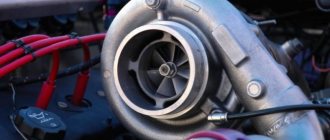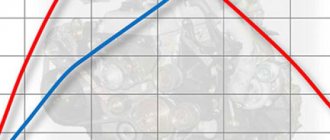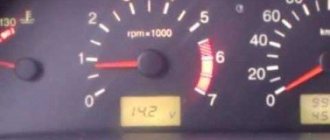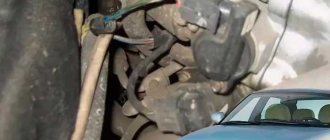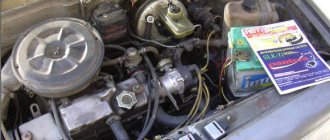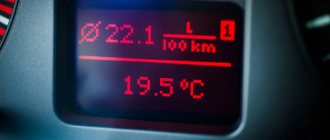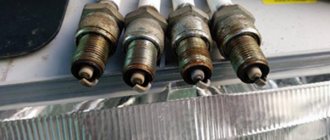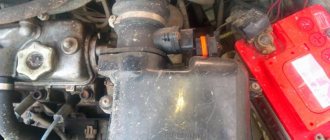In order to regulate and control the idle speed of a given car, you need to know the location of the sensor responsible for it. Finding it will not be difficult even for an inexperienced car enthusiast: it is located next to the throttle valve. The device is secured with two noticeable screws, so it is quite easy to recognize. The sensor must provide proper readings so that the engine and controller operate smoothly. Let's try to find out what air consumption is at idle for the VAZ-2114.
Air flow
DMVR diagnostic process
Air is directly related to the formation of the air-fuel mixture, and accordingly to fuel consumption. When this indicator changes, fuel consumption also changes.
Norms
So, let’s consider what is considered the standard air consumption: the Samara-2 engine, the volume of which is one and a half liters with a normally operating mass air flow sensor at 800-1000 rpm, should consume from 10±0.5 kg of air per hour of operation, and at - 2000 rpm - on average from 19 kg to 21 kg .
A decrease in air consumption leads to a decrease in fuel consumption, but the dynamic properties decrease significantly.
If the situation is the opposite - fuel consumption has increased, then fuel consumption will also increase, and the dynamics will increase accordingly. In this case, in cold weather there will be difficulties starting the power unit. If the sensor readings deviate from the real ones by 2-4 kg, the engine will begin to become very capricious and “dull”. Disabling the sensor will force the motor to continue operating in emergency mode.
Reasons for changes in air flow
Clean or change the air filter
Also, it is worth considering the reasons that may cause the air flow in the Samara-2 engine to change:
- DMVR malfunction. This sensor regulates the air supply and the formation of the correct reading of the air-fuel mixture in the engine. The malfunction is eliminated by checking the DMVR or replacing the damaged element. Also, do not forget that it is necessary to regularly clean the sensor.
- A throttle valve that regulates air flow. If the element is jammed or malfunctioning, it may supply too much or insufficient air to the cylinders. The malfunction is often eliminated by cleaning the element.
Even a slightly dirty throttle valve can affect air flow
How the sensor works and what is the air flow rate for VAZ-2114 cars
Understanding how the idle speed sensor works is not at all difficult. It all starts with turning the key in the ignition. Then a rod extends from the sensor and enters the calibration hole, which is located on the throttle pipe. The device then counts the required number of steps and returns the valve to its original position.
In order for an engine with 8 valves 1.5 or 1.6 to work properly, the proportion of air and fuel must be maintained. Idle air consumption for this car ranges from 8-10 kg/hour. In this case, the ratio of gasoline and air is 1 to 15.
Signs and causes of problems
Note that this device does not have an automatic fault diagnosis system, so it is quite difficult to determine the presence of such faults. However, it is very important to do this, since the functioning of the machine as a whole depends on the device. The main signs of a sensor malfunction are:
- failures in readings (incorrect data on air consumption);
- deterioration in vehicle acceleration;
- increased fuel consumption;
- problems when switching gears.
Most VAZ-2114 cars are equipped with an on-board computer, which displays errors in the operation of the sensor. Problems can be caused by:
- insufficient fixation of the contact block;
- oxidation of contacts;
- damage to the device;
- broken wires.
If malfunctions occur, you must take the car to a technical service to have the problems fixed.
There is no need to rush to replace the device, since it is likely that it just needs to be repaired. If you are not good at this, then it is better not to risk repairing the sensor yourself. In order to organize its work, you must have certain knowledge and skills. If you have never done this, then seek help from a specialist, as incorrect repairs can lead to serious problems with the operation of the engine and other components of the car. If you understand the insides of your vehicle, then proceed as follows:
- As a rule, the sensor can be adjusted to work properly by cleaning it. Cleaning is carried out using the necessary equipment or in a car service. Use a Phillips screwdriver to loosen the clamp that holds the air intake pipe.
- Then the corrugation is removed and the presence of traces of oil or condensation is checked, since they mainly provoke problems in the operation of the device.
- After this, the sensor is cleaned of dirt and a seal is installed.
- Next you need to check the tightness and return it to its place.
Every car enthusiast must ensure that all components of his iron horse are working properly. In the event of a breakdown, you need to immediately take the car to a service center or fix it yourself. Today on the Internet you can find many instructions and videos that show how to change or repair certain machine parts.
Device malfunctions and diagnostics
When a breakdown occurs, symptoms appear that are difficult to miss during constant use of the VAZ 2114:
• Motor power becomes lower; • The car does not start well even when it is hot; • Increased fuel consumption; • Acceleration is slower than usual.
These are the main diagnoses. They may also appear during other failures affecting the power plant. To be sure that the mass air flow sensor is not working properly, you need to check the device. There are a lot of ways to check a device, but two main ones are worth highlighting: visual inspection and testing with a multimeter.
Visual inspection
It is necessary to remove the clamp from the corrugation, which is attached to the air intake. You can unscrew it with a Phillips screwdriver. It is necessary to carefully check the surfaces of the corrugation and flow meter. They should have no traces of oil or condensation, and the sensor should be clean. But if the owner of a VAZ 2114 rarely changes the air filter, then you shouldn’t be surprised at the breakdown of the mass air flow sensor - the ingress of dirt will be fatal to the electronics.
Oil on the sensor is a warning that the oil level in the crankcase has increased, or a clogged oil sump may also be the cause. To test this theory, you need to remove the two fasteners with the tenth key and remove the flow meter from the filter housing. A rubber sealing ring must be installed on the inlet edge of the air filter. If it is not there, it means it has gotten into the air filter. In this situation, a small layer of dust appears on the inlet grid of the mass flow sensor. Such a defect also often damages the device, so it is necessary to change the air filter in the VAZ 2114 and also check it regularly. In the case of dust deposits, the VAZ 2114 sensor can be brought back to life - you need to carefully clean it, put on a seal and place it inside the case.
Checking with a multimeter
This method is suitable for modern flow meters. To check it, you need to turn on the multimeter and set it to measure DC current. The limit on the device should be set to 2 Volts. The MAF has the following pinout:
• Pink/black leads to the main relay; • The yellow wire goes to the signal input (it is located on the side of the windshield); • Green wire – ground; • Gray-white wire – voltage output.
While the colors may vary depending on the manufacturer, the layout always remains the same. Now you need to activate the ignition, but you do not need to start the engine. You should take a multimeter and connect its red probe to the yellow signal wire, and the black one to the green one. This combination allows you to measure the voltage between two elements. The ends of the tester probes allow you to take measurements without damaging the insulation of the structure - you need to go along the indicated wires.
Tip: It is not recommended to use attachments (for example, needles), as they cause errors. There should be a spread in the diagnosis of a mass air flow sensor, since every number is important.
The output voltage of the new device will be from 0.966 to 1.01 V. But over time, the indicator changes, usually the voltage increases upward. The more the indicator goes up, the more wear on the flow meter. By measuring you can determine the condition of the device:
• From 1.01 to 1.02 – the flow meter is working properly; • From 1.02 to 1.03 – tasks are being completed, but there is already wear and tear; • From 1.03 to 1.05 – the mass air flow sensor will soon be faulty; • From 1.5 and more – the sensor does not work and requires replacement.
How much does a new sensor cost?
Of course, car parts are not cheap, but if necessary, they must be purchased in order for the vehicle to work properly. The sensor should be purchased only in specialized stores where there is a guarantee, and where you can actually get competent advice. This spare part costs around 350 rubles. As a rule, such options are very reliable and durable. It makes no sense to buy cheaper ones, since their characteristics are in no way inferior to those that cost 350. It’s not worth buying cheaper ones, because these are mostly Chinese parts that are short-lived and of poor quality. If you find it difficult to choose, then ask the seller which sensor is better to choose. Basically they are all similar, the only difference is the price. Please note that this part can also be purchased online. The main thing is not to be cheap, but also not to spend all your money on one spare part.
As we can see, any part of the machine becomes unusable over time, so it needs to be replaced. As for the idle speed sensor, this device also needs to be replaced from time to time for the accuracy of the indicators. Quite often, due to a faulty sensor, a car begins to have problems with the engine, the speed deteriorates, etc. With such problems, it is quite dangerous to drive a car, since there is no guarantee that the engine will work without “whims,” and on the road this is very dangerous . You shouldn’t risk your most valuable assets; it’s better to send the car in for repairs or fix it yourself. A car, like any other device, must be used carefully and repaired as needed, then it will serve for a long time and reliably.
Functions of mass air flow sensor
What is the VAZ 2114 mass air flow sensor and what functions does it perform? The primary task of the regulator is to create arrogance from air and fuel vapors.
The regulator can measure two interconnected parameters, namely:
- reaction time;
- volume of air used.
In accordance with the information received, the correction device determines the required volume of components to create the mixture. If incorrect data is provided, the mixture will not be able to correspond to the operating mode of the power unit; accordingly, its power may decrease and fuel consumption may increase.
PURPOSE AND PRINCIPLE OF OPERATION
The VAZ 2114 injection engine is a complex design capable of operating in different load modes. In order to ensure normal operation of the power unit and the optimal amount of gasoline consumed, the car’s electronic brains must determine as accurately as possible the ratio of gasoline and air in the supplied fuel mixture.
To determine the required ratio of the proportions of the fuel mixture, the ECU uses the indicators of various measuring instruments - the main one is the mass air flow sensor.
Let's figure out what this DMRV is and what it is eaten with.
Mass air flow sensor (also known as a flow meter) is a sensor that determines the amount of air entering the car engine. Based on the obtained air consumption indicators, the ECU determines how much gasoline needs to be supplied to the combustion chambers.
The sensitive element of the sensor is represented by a thin platinum thread. During operation of the device, this thread heats up to a temperature of 1000 degrees and is cooled by the flow of passing air. The amount of air passed through is determined based on the temperature to which the sensitive element has cooled. The lower the temperature, the higher the conductivity of the platinum, and the greater the amount of current transmitted to the thread it conducts.
The cost of the sensor is about 2-3 thousand rubles. The products of the German company Bosch have proven themselves well, while the owners of the fourteenth, on the contrary, do not respond entirely positively to the domestically produced mass air flow sensor.
Optimal air flow
If the mass air flow sensor is operational, then when the engine is running at 900 rpm, the volume of air used will be at least 10 kg per hour. When the speed increases to 2 thousand, this figure will increase to approximately 20 kg. If the volume of air at such speeds drops, the dynamics of the vehicle will also decrease, and accordingly, this will lead to a decrease in gasoline consumption.
If these indicators increase, this will also contribute to an increase in fuel volume. If the parameter deviates by 2-4 kg, you should not allow it, since in this case the operation of the power unit may be incorrect.
Causes of malfunctions
The mass air flow sensor can break down not only due to problems in the crankcase ventilation. The ventilation system itself in the VAZ 2114 is dual-circuit; it is responsible for the operation of the internal combustion engine in closed or open throttle mode. When the damper is closed, gases from the crankcase escape through the line, but some of them remain in the idle line. The gas may come into contact with the MAF resistor on the VAZ 2114, and as a result of resin accumulating on its body, the device may produce incorrect data. Accordingly, this leads to various malfunctions of the regulator (video author - KOSSS102).
Useful video
You can learn more about the possibilities of reducing fuel consumption by watching the video below:
Maintaining the proper condition of the car in the future will save the owner from hassle and unexpected expenses. You just need to promptly replace clogged filters and damaged spark plugs, and then increased fuel consumption will bypass your car.
As is known, the fuel consumption of the VAZ-2114 Samara-2 engine directly depends on the air flow, which is regulated by the mass air flow sensor. But not all motorists know what standard is laid down in the regulatory and technical documents by the manufacturer.
Diagnosis of failure
If the air flow sensor breaks down, the symptoms of the malfunction can be very different. First of all, fuel consumption will increase; another symptom may be floating engine speed.
In addition to these signs of failure, the following can be identified:
- failures in the operation of the power unit;
- slower car acceleration, poor dynamics;
- the power unit can turn off when changing gears;
- decrease in power and increase in gasoline consumption;
- a heated internal combustion engine is more difficult to start;
- the Check light appears on the control panel.
The last symptom may not appear if the controller fails completely. How to check the MAF on your own? Diagnostics consists of identifying the impulse.
If the impulse is low, this indicates:
- possible short circuit or broken wiring;
- regulator failure;
- incorrect operation of the ECU;
- oxidation of contacts;
- that the controller is not connected.
Clogged air flow regulator
Check Features
To understand how the mass air flow sensor is checked, first find the device located in the engine compartment. On VAZ 2114 cars the regulator is located on the air filter line. How to check the sensor yourself?
First, the controller must be disconnected from the network; to do this, press on the wire fastening. Start the engine and let it run for a while. You need to drive the car a little - if it accelerates faster than usual, then this indicates a failure of the controller.
The diagnostic procedure can be carried out by replacing the firmware of the control unit. There is a small stop on the throttle; you need to place a plate under it, its thickness should be about 1 mm, thanks to this it will be possible to increase the speed. Then the power supply to the regulator is also turned off; when the device is operational, the motor should stall (video author - Vanechek 01rus).
Cleaning instructions
As practice shows, cleaning the mass air flow sensor is one of the most effective methods of restoring the functionality of the controller. Therefore, if the sensor breaks down, it is not necessary to change it, especially since such a pleasure today is not cheap. This procedure is necessary because over time it becomes dirty and shows other parameters.
So, how to clean the mass air flow sensor at home with your own hands:
- You will need a Phillips head screwdriver; use it to loosen the clamp securing the line from the air intake.
- Next, dismantle the corrugation and visually assess the condition of the system. You may see condensation or traces of engine fluid under the corrugation.
- Carefully inspect the inside of the controller. If everything is normal with the system, then there will be no traces of leaks or contamination. As practice shows, the sensitive element often breaks precisely due to an excess of contamination. In order not to avoid problems of this kind in the future, it is necessary to periodically replace the air filter. This procedure is carried out in accordance with technical regulations. Engine fluid may enter the controller as a result of an increased level of consumables in the crankcase. Accordingly, this occurs as a result of a clogged oil separator in the ventilation system.
- The regulator itself is fixed with two bolts on the line. The removal procedure is carried out using an open-end wrench. At this stage, if you are sure that the device has failed, you can replace it.
- You can see the entrance on which there will be a sealing rubber band designed to protect the device from the suction of dirty air flow. If you do not have a seal, it may have caught on the filter element. Accordingly, this will lead to the regulator input grid being contaminated.
- Clean the mesh using available materials. To do this, you can use a regular toothpick or toothbrush. After cleaning, the seal can be put back and the regulator can be put back in place.
Sorry, there are no surveys available at this time.
Examination
There are several ways to check the functionality of the flow sensor. But first you need to determine where the desired object is located.
And our hero is in the engine compartment. Find the air filter pipe there. It is on this that the mass air flow sensor is located, which monitors the air flow passing through the filter. Replacing it is simple - just dismantle the device by removing it from its fasteners and putting a new one in place.
Now regarding the verification.
- Disconnect the sensor by disconnecting the wiring harness from the connector. Press the latch at the bottom and you'll be good to go. Now start the engine and raise the speed to at least 1500 rpm. By turning off the sensor, the car will perceive this as an emergency condition, so the mixture will be prepared depending on the current throttle position. Drive a short distance. If the car accelerates faster than usual, the mass air flow sensor has definitely failed.
- Replace the firmware. The original firmware of the electronic control unit is often changed. Therefore, we cannot find out which sensor operation algorithm was prescribed in the case of the first verification method. The throttle valve has a stop; a plate approximately 1 millimeter thick should be placed under it. This will increase the speed. Now the chip with the sensor is disabled. If the mass air flow sensor does not work, the engine will stall. If this does not happen, then the firmware is not original, the steps of the idle speed control are written incorrectly.
Checking with a multimeter
To do this, you will have to use a multimeter. And how can I check the functionality of the sensor using this method? Select the DC voltage measurement mode on the device and set the maximum value to 2V.
Check with a multimeter
Separately, you should familiarize yourself with the connection diagram in the case of the VAZ 2114.
Subsequence
Wire color
Meaning
Power output
Main relay output
In some cases, the color may differ, but the sequence always remains the same. This will prevent you from getting confused.
Turn on the ignition with the engine off. The positive probe of the multimeter is connected to the yellow output of the sensor, and the black, that is, positive, goes to the green.
The probes of the measuring device should be inserted through the rubber seals of the connectors without damaging the insulation. The probes should be moistened with the almighty WD 40. Now measure the voltage readings. Compare the result obtained with the data from the table.
Voltage indicator
Air flow sensor condition
The air flow sensor is in good working order, almost new condition, can serve for a long time
The sensor is in good condition, although old. There are no complaints about performance
The air flow sensor is in poor condition, has almost expired and will require immediate replacement
The condition is critical, the resource is exhausted. It is recommended to replace it as soon as possible to avoid troubles.
If you install a new sensor, it will initially show readings in the region of 0.996-1.01 V, but over time the voltage will begin to increase. This indicates wear.
Cleaning
Cleaning is one of the most effective ways to bring the mass air flow sensor back to life and ensure its operation for more than one season of operation of your VAZ 2114.
Let's figure out how to clean this measuring device.
- Using a Phillips screwdriver, loosen the clamp that holds the pipe from the air intake.
- Remove the corrugation and check if there are traces of oil or condensation inside.
- Examine the condition of the internal surface of the mass air flow sensor itself.
- If everything is fine, there should be no traces of contamination.
- The sensitive component of the sensor often fails due to contamination.
Mass air flow sensor VAZ 2114
- Amount of air consumed;
- Reaction time.
The accuracy of measuring the air consumption of the engine allows the controller to determine in what proportion it is necessary to mix air with fuel. If the sensor produces incorrect values, the resulting air-fuel mixture does not correspond to the current engine operating mode. This leads to a decrease in power, an increase in fuel consumption, and a deterioration in the dynamics and response of the car. The response of controllers from different manufacturers to these parameters may differ.
For example, January-5.1, in case of slight overestimation or underestimation of values, determines the error of the mass air flow sensor based on the readings of the oxygen sensor, thus adjusting the duration of fuel injection. Increasing the sensor response time will cause the controller to not keep up, and at the time of acceleration you will notice “dips” of the engine. The same sensor error when using a more sensitive Bosch controller will lead to floating idle speed, although there will be no noticeable dips during acceleration.
FakeHeader
Comments 44
Hello, I have the same problem (e-gas) 1.1 and the average consumption is about 11, did you solve the problem?
We all loosen the throttle cable together and it will be 0.9
e-gas does not have a cable (e-gas is an electronic gas)
did you solve the issue? I cleaned the damper and now the idle is 1.2l/h.
I cleaned it and now it holds 1.3-1.5
Similar car. At temperatures up to 90 - consumption 1.1 - 1.3. After warming up, the flow rate is 0.9-1.1. Consumption per 100 km: highway - 6-7l, city - 8l.
1.1-1.3 when warmed up
I have 14 e-gas 1.6 shows 0.9 when connected via elm, I even thought that a lot turns out to be the norm))
My father’s 14k xx is warmed up to 0.8…0.7 And I have 1.1–1.3…0.9 fuck you understand
The car is different, but the principle is the same. On my Volga 3102 ZMZ 406 the consumption was 1.6 l/h. The mass air flow sensor was faulty, which distorted and overestimated the data on air consumption, thereby the controller produces more fuel. In rare cases, cleaning the air flow sensor with carburetor cleaning fluid helps. It didn’t help me and I bought a Pekar mass air flow sensor. After replacement, the consumption at idle became 0.9-1.1 l/h. 70% distortion
It may be surprising, but with the Sti-3 shaft the consumption at xx, on a warm engine is on average 0.5 liters (+-0.05) no more, xx is on average 1000, on average because with this shaft there are “holes of holes of holes)))” oh yes, I set the firmware to adjust the bcn for DTV and spent a long time going through the logs) for those who don’t believe me, I can attach the log
Fuel consumption depends on many things! Sensors, engine wear, firmware. many sensors, ranging from air to lambda probes. Wear of the piston system, namely the rings, the intake-exhaust system, namely from the claons. And I’m generally silent about the firmware... so essentially the consumption should be 0.9 -1.0, well, I mean for the stock firmware and units. I have a VAZ 2114 1.5 after a complete overhaul and after running in with the corrected units, the consumption is 0.8-0.9, so figure out what’s wrong with you... In short, there are many reasons, we need to figure it out!)
The mass air flow sensor is necessary for efficient engine operation in different modes. The function of this device is to create a working mixture of air and gasoline vapor. The task of the VAZ 2114 air flow sensor is to measure two interrelated indicators:
- Amount of air consumed;
- Reaction time.
What air flow should be on a VAZ 2114?
A 1.5 liter VAZ 2114 engine with a working mass air flow sensor at 850-950 rpm consumes from 10±0.5 kg of air per hour of operation, and at 2000 rpm - from 19 kg to 21 kg. If the amount of air consumed at the same speed decreases, the dynamics of the car also decreases, but fuel is saved. Conversely, increased air consumption leads to increased dynamics and higher fuel consumption. In this case, it may be difficult to start the engine in cold weather. If the sensor readings deviate from the real ones by 2-4 kg, the engine will begin to become very capricious and “dull”. Disabling the sensor will force the motor to continue operating in emergency mode.
Engine 1.6 model 21126
In 2010, the popular 1.6 engine with sixteen valves was modified, as a result of which it began to produce 98 horsepower, accelerating the car to 190 km/h, and to the first hundred in 11.2 seconds. Gasoline consumption of this modification:
- heavy traffic 9.5 l;
- mixed cycle 7 l;
- highway 5.4 l.
Real consumption
- Igor, Moscow. A universal option for city and country trips. The 1.6 engine with a manual transmission is very reliable, responsive and unpretentious. Measurements showed that the consumption practically corresponds to the passport value. On the highway, 5.5 liters of AI 95 are consumed per 100 kilometers; in the city, even in winter, no more than 10.
- Yaroslav, Kharkov. I consider the VAZ 2114 one of the most successful cars, but it requires timely maintenance, especially the 1.6 engine with 98 horses. The transmission and chassis are very reliable, consumption does not exceed 9 liters, in a circle it turns out to be about 7 liters per hundred.
- Stepan, Kazan. I bought a new car in 2010 with a 1.6 engine. Initially, I was worried about the consumption - in the city it reached 12 liters, I was looking for the reasons for the high fuel consumption in my VAZ 2114, but after the run-in everything fell into place: 9 in traffic jams and 6 on the free road, even if driving energetically. Comfort is a little weak, but otherwise a very good car - reliable, dynamic, inexpensive to maintain.
- Ivan, Ryazan. I bought a VAZ 2114 in 2010, during which time I can say that the money was well spent. The car pulls excellently, it is reliable and easily digests 92-octane gasoline. The suspension is ideally adapted for our roads, the mechanics do not cause any complaints. Consumption is also pleasing - in the urban cycle it does not exceed 10 liters, and on the highway you can easily keep it to 6.
- Boris, Smolensk. I often travel to Minsk for work, so I need a reliable and economical car. The VAZ 2114 with a 1.6 engine producing 98 horsepower met these criteria, and for quite reasonable money. Fuel consumption on the highway is about 6 liters, I drive around the city less often, here you will need up to 9 liters per hundred.
Causes of malfunction
Common to most domestic cars, the reason why the VAZ 2114 air flow sensor breaks is hidden in the crankcase ventilation system. It has two circuits that ensure operation with the throttle valve open or closed. If the throttle is buried, crankcase gases are discharged along the line (d=1.5 mm) into the space available behind it. A certain percentage of these gases accumulates in the idle line, where it comes into contact with the film-coated MAF resistor. It is also sensitive to fluctuations in the gas mixture in the intake system. The resin settles on the surface of the resistor, and the sensor begins to “lie.” Because of this, the idle air control sticks, and it begins to jam when starting the engine.
Symptoms of a problem
A non-working VAZ 2114 mass air flow sensor leads to the appearance of a number of symptoms in the behavior of the injection engine. The malfunction appears gradually, starting with an increase in fuel consumption and floating speed, ultimately destabilizing engine operation.
From personal experience using a front-wheel drive car as an example, I can say that I encountered the following problem: first the injector icon came on, then the speed began to fluctuate greatly and fuel consumption almost doubled.
You can calculate a non-working VAZ 2114 air sensor using the following criteria:
- failures when idling and under load;
- The internal combustion engine stalls when trying to change gear;
- decreased dynamics, the car accelerates slowly;
- fuel consumption increased;
- engine power has dropped;
- Badly ;
- The Check Engine signal appears.
If the mass air flow sensor is already dead, the Check Engine light may not come on. Then the malfunction can be determined by the error generated by the on-board computer. Diagnostics of the MAF signal level will also help. A low level may indicate the following:
- There is no MAF connection;
- malfunction in the sensor connection circuit (break);
- the ground in the connection circuit is broken or oxidized;
- the signal wires are broken or incorrectly connected, perhaps they are short-circuited;
- engine control unit malfunction;
- DMRV does not work.
If you notice the above signs, do not rush to buy a new sensor. It is by no means the cheapest and will cost 1500-4000 rubles. First of all, make sure that this is the reason. You can check and clean the old one at a service center or yourself if you have the necessary equipment.
What is a mass air flow sensor, why is it important and how to diagnose its malfunction
Over the past three decades, engines with distributed and direct fuel injection have finally supplanted all other types of designs. It would seem that this is a considerable period of time, but engineers have not been able to overcome the “childhood diseases” of important electronic components, including the mass air flow sensor (MAF), which is responsible for the composition of the air-fuel mixture. Let's remember how the mass air flow sensor works, why it is so important and how to diagnose its malfunction.
What is DMRV
Modern engines use two types of power supply systems: with distributed injection, the nozzle supplies fuel to the intake pipe, with direct injection, it supplies fuel to the combustion chamber. For both systems, the correct operation of the mass air flow sensor, which was once mechanical (vane type), but is now devoid of moving mechanical parts and made hot-wire (from “anemo” - wind), is important.
Factory air flow sensor made in Germany for a VAZ engine
The mass air flow sensor can be installed not only on a gasoline engine, but also on a diesel engine, where the operation of the EGR valve (exhaust gas recirculation system) is “tied” to it.
As old-school drivers used to say, an internal combustion engine does not work in two cases: there is nothing to burn or there is nothing to set it on fire. The mass air flow sensor precisely informs the electronic control unit about the amount of incoming air, the oxygen of which becomes the “fuel” for the working mixture. Having received such a signal, the ECU can ensure the most complete combustion possible. The device, located in the intake tract, consists of two resistors, which can be designed in various designs. In the first case, the resistor is exposed to passing air: when the flow intensity changes, it cools and its internal resistance changes. In the second case, it is not blown - based on the difference in readings from two resistors, the volume of air that needs to be supplied to the cylinders is calculated.
The sensor is supplied to the aftermarket with protective caps to prevent contamination during transportation.
This is what the sensor looks like on a regular VAZ engine. It will not be possible to remove it from the case without a special key.
The removed sensor is in its “bare” state. The sensitive element is clearly visible
Based on the data on the mass and temperature of the incoming air, the ECU determines its density, and also calculates the duration of opening of the injectors and the amount of fuel supplied to the combustion chamber. In general, the mass air flow sensor is important for achieving maximum engine power, for more complete combustion (environmentally friendly), and for economical driving. The failure of this sensor, like most others, causes the Check Engine warning light to go off.
The check engine light can come on for any reason. If there is no on-board computer with a diagnostic function, you will have to go to a service station where there is a scanner
However, the owner does not always associate the triggered “check” with the mass air flow sensor - especially if the engine runs without any interruptions, and the dynamic characteristics of the car have not deteriorated at all. Therefore, it is important not to leave the illuminated engine malfunction indicator unattended, but to consider errors with the diagnostic computer.
MAF or DBP?
The absolute pressure sensor (MAP), together with the temperature sensor (DTS), also controls how much air enters the intake manifold. Based on these readings, the controller generates a pulse command to the injectors. An important difference between DBP and MAF is the absence of air in the housing, since this sensor works based on measuring the difference in inlet pressure and pressure in the vacuum chamber. A design feature of the DBP is a highly sensitive diaphragm, which expands under the influence of pressure in the intake manifold. This process affects the resistance of the strain gauges, as a result of which the voltage changes.
The absolute pressure sensor (pictured) and the mass air flow sensor operate on different principles
DBP is much cheaper than a mass air flow sensor, but its operating algorithm is less advanced. And in general, not all control units can work correctly with DBP. Moreover, when switching to an absolute pressure sensor, the engine may respond to opening the throttle with a much greater delay than with the original mass air flow sensor. And, of course, simply replacing the mass air flow sensor with a DBP without serious modifications will not work due to the difference in their design and even location.
There are engines where there is no choice between DBP and MAF, because both of these sensors are present on the engine at once!
Usually, thoughts about installing a DBP instead of a standard mass air flow sensor appear when the latter fails, as well as during engine tuning - especially if the aspirated system is converted to turbocharging. However, some owners deliberately refuse the mass air flow sensor because of its high cost and not the greatest resource. Indeed, in an unfortunate combination of circumstances, the sensor can fail after 60-70 thousand kilometers, and by the figure of 120-130 thousand on the odometer of many budget cars, it is almost guaranteed to “die”.
But those who don’t bother with engine modifications usually drive with a standard mass air flow sensor, rather than replacing it with a DBP+DTV (air temperature sensor) combination. Moreover, not all engine control units work better with an absolute pressure sensor than with the original mass air flow sensor. It is difficult to answer unequivocally which sensor is more advanced in design, especially if we are talking about an attempt to replace one (and often already faulty) flow meter with another. After all, history knows many examples when happy owners clocked up several hundred thousand kilometers both on an engine with a native flow meter and on an engine with an absolute pressure sensor, especially if the latter was standardly installed at the factory.
Is it possible to do without it?
Failure of the mass air flow sensor causes the check to be triggered, but the engine will continue to operate. True, depending on the newness of the ECU firmware, the “emergency” program, without seeing a signal, can raise the idle speed to approximately 1,500 rpm. On relatively new software versions, a sensor malfunction only leads to an increase in fuel consumption or a drop in dynamics. In any case, an error in the mass air flow sensor is an important reason to check it, at least by measuring the voltage.
If the mass air flow sensor does not operate correctly, the electronics may begin to over-enrich the working mixture.
The malfunction should not be ignored, since even on relatively simple cars (the front-wheel drive Lada line of the first generations), failure of the mass air flow sensor threatens a noticeable excess consumption of gasoline or a weakening of the engine’s output characteristics. That is why the answer to the popular question “Is it possible to do without a mass air flow sensor if it is included in the design of the car?” is unambiguous and sounds like this: no, you can’t.
How to diagnose a malfunction?
In addition to the indirect signs that we mentioned above, there is a completely objective parameter that indicates the condition of the sensor and its resource - this is the operating voltage when the ignition is on. Let's study it using the example of the VAZ sensor as one of the most common.
Connection diagram for mass air flow sensor on a VAZ engine
By connecting the multimeter in DC voltage measurement mode and turning on the ignition, you can take readings of the mass air flow sensor output voltage. For a new or “reference” part it is 0.996 V.
This voltage indicates that the sensor is working like new.
One of the options for measuring voltage is directly through the sensor connection connector
Then the parameters are evaluated as follows:
1.010-1.019 V - good condition, you don’t need to think about replacing yet 1.020-1.029 V - the sensor is operational, this is about half of the remaining life 1.030-1.039 V - still in good condition, but its life is coming to an end 1.040-1.049 V - mass air flow sensor is on the verge of breaking down building, will soon require replacement 1,050 V and above - the flow meter requires immediate replacement
With a parameter of 1.016 V (first photo), the sensor is in good condition, but 1.035 V is already a reason to think about buying a new one
The sensor produces this parameter on the verge of serviceability, but you need to make sure that the data corresponds to reality and is not related to the error of the multimeter
It should be taken into account that many testers overestimate readings, so there is a risk of “sentencing” a completely serviceable sensor. In addition, its parameters largely depend on the purity of the “mass” in the circuit.
Poor crimping of wires or a rotten “braid” can affect the correct operation of both the mass flow sensor and the DBP, which is especially typical for engines of old cars.
It is best to first install a known-good “used” one before purchasing a sensor that is not the cheapest, borrowing it for testing for a while from a work colleague, a neighbor in the parking lot, a friend from a forum with the same car, etc. You should also trust the readings of a diagnostic scanner connected to the OBD-2 connector more than a cheap multimeter.
To rinse or not?
Many mechanics with many years of experience and ordinary car owners are confident that a “tired” mass air flow sensor can be revived by simply washing it - that is, remove it from the body and thoroughly “spill” it with some “carb cleaner” or alcohol in about the same way as 20-30 years ago they did this with carburetor jets. In fact, there are specialized sensor cleaning compounds that have nothing in common with the deposit solvents used to flush carburetors. Therefore, the price of such “narrowly sharpened” air flow sensor cleaners is completely different - and, as one can easily assume, higher. In addition, the manufacturers of such liquids directly indicate that they will not do miracles and will not turn a “half-dead” sensor into a completely new one, but are intended for preventive flushing of working mass air flow sensors - to remove contaminants associated with dust and oil mist that has entered the intake tract from the ventilation system crankcase
Please note: for flushing, a specialized composition is used specifically for cleaning the air flow sensor, and not a universal carburetor or fuel system cleaner
Practical experience in using such “miracle remedies” shows that they can indeed slightly reduce the readings of a still working sensor, but for those that go beyond 1.05 V, such manipulations will be like a poultice for the dead.
The main thing is not to damage the removed sensor, which is afraid even of dust, not to mention mechanical impact.
Many drivers, due to inexperience, themselves destroy still living sensors when washing. Sensitive elements should not be touched with hands or wiped with a rag, and strong pressure of liquid will do nothing but harm. Therefore, cleaning the mass flow sensor in a garage should be treated with great caution and remember: if the sensor has already “died”, then this is harmless and will no longer help it, but even if it is still in good working order, this procedure may not bring a noticeable result.
